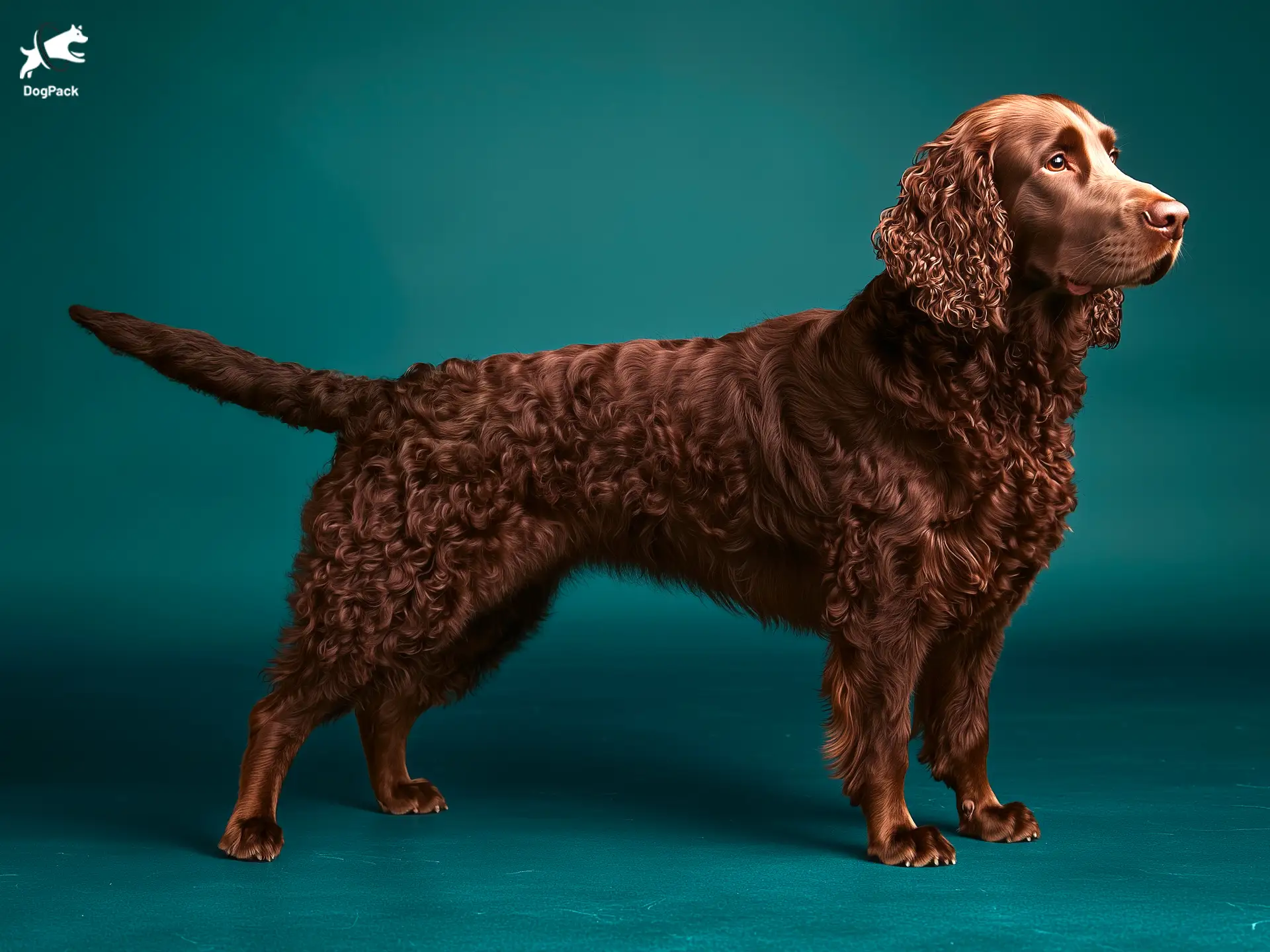Murray River Retriever Dog Breed Info & Overview
Often celebrated as an Australian treasure, the Murray River Retriever is a versatile and active companion prized by those who love outdoor adventures. Built for both water-based activities and relaxed family living, this dog brings a spirited energy to any household. With loyal tendencies and a friendly nature, it’s easy to see why many consider this breed a hidden gem.
Characteristics
Pictures
Breed History
Originating in Australia along the banks of the Murray River, this rare retriever was initially bred for waterfowl hunting. Early records trace it back to local communities who prized a hardworking companion capable of swimming in strong currents. Over time, the dog’s keen retrieving skills and pleasant temperament made it an important fixture in rural households that depended on reliable hunting partners.
The breed’s name comes directly from the region where it excelled in retrieving ducks and other water birds. While less famous than other retrievers around the world, it carved out a special niche as a dedicated and tenacious hunter. Individuals often recount stories of how these canines bravely waded into murky waters, showing unwavering commitment to bringing back prized game.
A concerted effort by enthusiasts ensured the Murray River Retriever did not fade into obscurity. Passionate breeders championed its preservation and lobbied for recognition among rare dog breeds. Despite maintaining a relatively low profile, the breed’s historical importance as an Australian hunting ally contributes to its growing popularity among those seeking an unusual but remarkable companion.
Temperament, Personality
Known for a warm and affectionate demeanor, these dogs love being around their families. They thrive on attention, revel in games of fetch, and eagerly jump at any chance to explore new environments. Their loyalty to household members is notable—if you’re reading a book on the sofa, don’t be surprised if you find a curly-haired friend nuzzling at your side.
Despite their outgoing nature, they can be slightly reserved with unfamiliar people at first. Early socialization is key to preventing any wariness from developing into shyness. Taking them to dog-friendly parks or inviting friends over often helps them broaden their circle. With consistent exposure, a Murray River Retriever typically greets everyone with a wagging tail and a curious tilt of the head.
Families with children often find this breed’s playful nature a perfect match for active youngsters. Thanks to a generally even temper and love for interactive play, they’re great at burning off youthful energy. Of course, supervising any dog around very small children is still important. As they settle into family life, their gentle side emerges, turning them into loyal guardians of little ones.
Physical Characteristics
Tall and sturdy, the Murray River Retriever carries itself with confident purpose. Its athletic build stands out, and it’s easy to see how it powers through water with ease. A robust chest and well-muscled legs aid in swimming and endurance, crucial for an avid retriever that once spent long hours wading in streams and rivers.
Perhaps the most striking feature is the slightly curly coat, which comes in various liver or chocolate shades. The curls help repel water, ensuring the dog can stay warm and dry on extended hunts. Their eyes, often amber or brown, give them a gentle yet focused expression that is hard to resist. A moderate-length tail completes the classic retriever silhouette.
This breed’s webbed feet also contribute to its water prowess, allowing for efficient movement through calm lakes or swift currents. While not as bulky as some other large dog breeds, it exhibits a functional balance of athleticism and grace. Whether relaxing in the backyard or racing down a riverbank, its physique embodies the spirit of an adaptable, outdoor-ready companion.
Health Issues
Like many active dogs, the Murray River Retriever can be prone to hip and elbow dysplasia. Regular veterinary checkups are vital for early detection, as subtle mobility issues can advance quickly if left unmanaged. Keeping an eye on weight is another key factor, as extra pounds exacerbate joint stress. Routine exercise and a balanced diet help maintain optimal body condition.
Eye health should also be monitored, given the possibility of inherited conditions like progressive retinal atrophy. Although not overly common, owners should remain vigilant, especially in later years. Yearly vet visits with thorough examinations can catch emerging problems in their early stages.
Skin irritations, often related to the water-resistant coat, can crop up if the fur remains damp for too long. Drying off after swims and frequent brushing help stave off infections or rashes. In general, the Murray River Retriever is relatively robust, but dedicated preventive care—including vaccinations, parasite control, and a keen watch on changing behaviors—will help ensure a long, healthy life.
Grooming Needs
The breed’s distinctive curls do an impressive job at shielding against water, but they also trap dirt if neglected. Weekly brushing with a slicker brush or comb helps remove debris and loose fur, preventing matting. If you’re a neat freak, consider the reality that their bouncy curls can sometimes shed lightly around the house—though not nearly as heavily as some double-coated breeds.
Regular baths are recommended, especially for an active Murray River Retriever that loves muddy excursions. However, overbathing can strip natural oils, so it’s best to bathe them every month or so, or when truly needed. A specialized shampoo for curly coats can help maintain softness and shine, while also rinsing away any musty smells from lake or river adventures.
Pay special attention to the ears. Moisture can accumulate after a swim, leading to ear infections if not properly dried. A quick wipe with a vet-approved ear cleaner goes a long way in preventing problems. Nail trims, teeth cleaning, and occasional professional grooming round out the routine. With consistent care, the breed’s distinctive appearance remains both functional and eye-catching.
Exercise Requirements
Most owners quickly discover that this dog isn’t one to lounge around all day. A daily walk or jog is barely the beginning. They crave vigorous activities such as swimming, retrieving games, or hikes across varied terrains. Interactive toys—especially those you can throw into a pond—bring out their playful side while also delivering essential physical challenges.
Because of its keen retrieving instincts, play sessions that simulate hunting can be especially rewarding. Tossing dummy waterfowl toys or training with retrieval drills keeps their mind sharp and muscles toned. This breed loves to be outdoors, so plan for at least one long outing per day. If your schedule is hectic, enrolling in doggie day camps that offer supervised play can be a game-changer.
Leaving a Murray River Retriever under-exercised can lead to restless behaviors, including digging or chewing. They thrive in homes with spacious yards, but apartment life isn’t impossible if you commit to daily exercise. For multi-pet households, introducing them to playful companions can help burn off extra energy. Remember, mental stimulation—like puzzle feeders or scent-tracking games—is equally essential for this energetic breed.
Training Tips
Eager to please and smart, a Murray River Retriever usually takes to training with enthusiasm. Start basic obedience when they’re young to develop good habits early. Positive reinforcement with treats, praise, or playtime works wonders, especially when teaching commands like “sit,” “stay,” and “come.” Break lessons into short sessions to keep them engaged and reduce boredom.
They do have a curious streak, which can mean wandering off if something grabs their attention. Consistent recall training is crucial. Gradual steps—starting indoors, then moving to fenced yards, and finally practicing in open areas—help instill confidence. If you notice stubbornness, try mixing up training locations or offering higher-value treats to keep them motivated and interested.
Socialization is just as pivotal as obedience. Exposing your dog to different environments, people, and other animals helps broaden their comfort zone. Early experiences with calm children or gentle dogs encourage friendly interactions later. If you’re new to dog training, consider enlisting a professional trainer who has experience with sporting breeds. This extra guidance ensures a harmonious start for everyone.
Nutrition, Diet
Because of their high activity level, a Murray River Retriever typically does well on a diet formulated for energetic, medium-to-large sporting dogs. Look for balanced dog food with quality protein (chicken, fish, or lamb) listed first. Aim for a fat content that supports sustained energy—approximately 15% to 20%—to fuel their outdoor adventures without adding unhealthy weight.
Adult dogs usually require around 2.5 to 3.5 cups of nutrient-rich kibble per day, split into two meals. For example, a 60-pound dog working moderately might need 3 cups, while a 75-pound dog with intense daily exercise could edge closer to 3.5 cups. Adjust portions based on individual metabolism and activity levels—monitoring body condition is key.
Many owners incorporate raw or fresh components—like lean meats or cooked vegetables—into meals to diversify nutrients. When adding extras, be mindful of overall calorie intake to avoid unwanted weight gain. Omega-3-rich fish oil supplements can benefit skin and joint health, especially for a water-loving retriever. Always consult a veterinarian to tailor a specific meal plan that suits your dog’s lifestyle and genetic predispositions.
Adoption, Breeders
Locating a Murray River Retriever can be a challenge, as they remain relatively rare outside of Australia. Begin by researching recognized breeders who maintain ethical standards—healthy lineage records, proper socialization practices, and transparent medical screenings. Ask lots of questions, request kennel visits, and interact with parent dogs to gauge temperament. This breed’s reputation for loyalty and vigor is best preserved by conscientious breeding programs.
If buying from a breeder, look for endorsements or membership in reputable organizations like the Murray River Retriever Club of Australia or state-based kennel clubs. Official breed clubs often have strict regulations about health testing and living conditions. Murray River Retriever Association is a useful resource for breed details, upcoming litters, and community events celebrating this unique Aussie heritage.
Adoption is another fantastic route if you prefer to rescue a dog in need. Occasionally, specialized rescue groups or broader sites like Petfinder list this breed, though availability can be sparse. Fostering first provides valuable insight into compatibility, ensuring a smoother transition should you commit. Whether adopting or buying, patience and due diligence are crucial for finding a well-matched companion.
Family Pet?
Many households find that a Murray River Retriever integrates beautifully, especially with children who love to play. Their gentle mouths and eagerness for fetch make them a safe, interactive friend for older kids. That said, teach youngsters proper dog-handling techniques. Even a friendly pup can get startled by quick movements or ear-tugging, so supervised interactions foster mutual respect and fun.
Surprisingly adaptable to different family types, this breed can handle both lively gatherings and quiet nights in. They relish being part of daily activities—whether that’s jogging alongside a stroller or napping by your feet during movie night. When introduced appropriately, they tend to do well with other pets, too, though a bit of patience is necessary to establish harmonious relationships.
Having a secure yard is highly beneficial for letting them burn off energy at will. Though not strictly necessary, it does make life easier if you have energetic children or multiple pets. Their sociable, big-hearted nature often wins over grandparents, neighbors, and even the mail carrier. If you’re searching for a dog that fits seamlessly into a vibrant family setting, this could be your match.
Right For You?
Before deciding on this breed, consider your lifestyle. If you’re an avid hiker, swimmer, or someone who craves an outgoing, outdoorsy companion, the Murray River Retriever could be ideal. They excel with owners who enjoy providing both mental and physical challenges. However, if long walks aren’t your thing and you prefer minimal grooming, be ready to adapt—these dogs thrive under active, hands-on care.
Apartment dwellers or those frequently away from home might struggle meeting the breed’s exercise demands. While they can adapt to smaller spaces, underestimating their need for daily activities can lead to frustration for both dog and owner. If you’re open to a routine of play sessions, occasional grooming sessions, and ongoing training, you’ll find an affectionate and earnest canine by your side.
Ultimately, this is a dog for people who find joy in a bit of adventure. If you appreciate a loyal friend who will hike a mountain trail with you, then cuddle up on the couch afterward, this breed might be calling your name. Take an honest look at your energy level and commitment. That will help you determine if this energetic Aussie treasure is truly right for you.
Conclusion
Highly energetic yet wonderfully affectionate, the Murray River Retriever offers a blend of water-loving talent and dependable companionship. Best suited for families or individuals who enjoy outdoor adventures, this curly-coated breed rewards dedication and proper training with unwavering loyalty. If you’re seeking a dog that excels in both spirited activities and cozy family moments, the Murray River Retriever could be your ideal companion.
FAQs
-
How does the Murray River Retriever differ from other retrievers?
The Murray River Retriever is a rare Australian breed with a curly, water-resistant coat, distinguishing it from Labradors and Golden Retrievers. Bred for duck hunting along the Murray River, they are smaller, more agile, and highly adaptable to rugged terrain and water work.
-
Is the Murray River Retriever recognized by major kennel clubs?
While not yet recognized by AKC or FCI, the Murray River Retriever is gaining recognition in Australia. Breed enthusiasts are working toward official classification, and the breed is acknowledged by Australian rare breed registries.
-
How well does the Murray River Retriever handle extreme temperatures?
Due to their dense, curly coat, Murray River Retrievers excel in cold and wet conditions, ideal for water retrieving. However, in hot climates, they require shade, water access, and reduced activity during peak heat to avoid overheating.
-
Are Murray River Retrievers good off-leash dogs?
Yes, they have a strong recall when properly trained. However, their natural hunting drive means they may chase birds or small animals. Consistent recall training and supervision in open areas help reinforce good behavior.
-
Do Murray River Retrievers make good family pets?
Yes! They are affectionate, intelligent, and highly trainable, making them great for active families. They require regular exercise and mental stimulation, so they are best suited for owners who enjoy outdoor activities like hiking, swimming, and retrieving games.
Breed Ratings
The Murray River Retriever is bright and responsive, especially when treats or toys are involved.
This breed is spirited and loves games of fetch or any outdoor adventure that lets them romp around.
High-octane pups, they need plenty of daily exercise and mental challenges to stay happy and healthy.
Expect moderate shedding, but consistent grooming helps minimize loose hairs and keep curls tidy.
Bred for waterfowl retrieving, they have a fairly strong desire to chase moving critters.
Regular brushing and occasional baths are necessary, especially if they’ve had aquatic outings.
Generally eager to please, they respond well to positive methods and consistent practice.
They bond closely with family and may become anxious if left solo for extended periods.
Expect moderate vocalization, particularly if they need attention or sense something amiss.
Not excessive droolers, but can get messy when returning from a big swim or long fetch session.
Typically amicable with other dogs, though early socialization sets the stage for peaceful coexistence.
Robust overall, but proactive veterinary care is key to detecting and managing potential issues.













